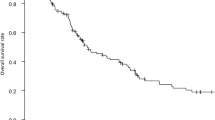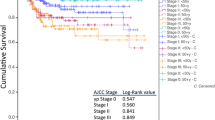Abstract.
The purpose of this study was to evaluate the influence of clinicopathologic factors on colorectal cancer, especially the age factor. From 1986 to 1992 a total of 2082 cases of colorectal cancers underwent operation in our institution. After exclusion of familial adenomatous polyposis, multiple cancer, Dukes' D stage, and nonadenocarcinoma patients, there were 1124 patients with single colorectal adenocarcinoma who had undergone curative operation; 1110 cases were included in the study after exclusion of surgical mortalities (14 cases, 1.2%). Age distribution ranged from 19 to 91 years (mean 58 years). The patients were divided into three age groups: < 40 years (grade 1), 40–69 years (grade 2), ≥ 70 years (grade 3); other clinicopathologic factors including gender, tumor gross type, location, pathology, and stage were also evaluated in the study. The colonic/rectal cancer ratio was 1.00:1.74, and that of the male/female distribution was 1.00:0.84. The overall 5-year cancer-free rate was 69.9% after curative resection. The young age (< 40 years) patients comprised more women (53.6%) and had a colon location in 41%. Although they had a higher percentage of scirrhous type lesions (1.8%), worse histology (17%), and more advanced stage (49.1%) than the older groups, their survival rate was only slightly lower than the other two groups (67% vs. 70% and 72%, respectively), which was not statistically significant (p= 0.83). By univariate analysis, the factors that influenced the 5-year cancer-free rate were gender (p= 0.031), tumor location (p= 0.003), gross type (p= 0.000), pathology (p= 0.000), and stage (p= 0.001). The independent factors determined for the 5-year cancer-free rate after multivariate analysis were similar to those assessed by univariate analysis. There 5-year survival of colorectal adenocarcinoma was not poorer in young patients. Poor survival factors were male gender, rectal location, scirrhous type, poor and mucinous histology, and advanced stage (Dukes' C) found at curative resection for colorectal adenocarcinoma.
Similar content being viewed by others
Author information
Authors and Affiliations
Rights and permissions
About this article
Cite this article
Han-Shiang, C. Curative Resection of Colorectal Adenocarcinoma: Multivariate Analysis of 5-Year Follow-up. World J. Surg. 23, 1301–1306 (1999). https://doi.org/10.1007/s002689900666
Published:
Issue Date:
DOI: https://doi.org/10.1007/s002689900666




